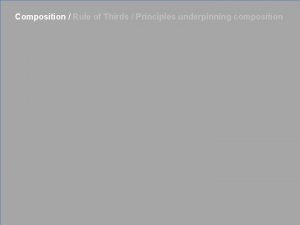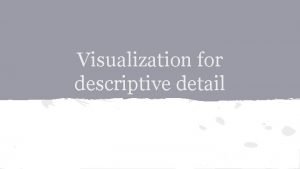VISUALIZATION COMPOSITION VISUALIZATION Visualization is the use of










- Slides: 10

VISUALIZATION & COMPOSITION

VISUALIZATION Visualization is the use of the imagination through pictures or mental imagery to create visions of what a person want in his lives and how to make them happen VISUALIZATION Visualization or visualisation is any technique for creating images, diagrams, or animations to communicate a message. Visualization through visual imagery has been an effective way to communicate both abstract and concrete ideas since the dawn of humanity. ● Go somewhere quiet and private where you won't be disturbed. ● Close your eyes and think of the goal, mood, new behavior or skill that you want to acquire. ● Take several deep breaths and relax. ● Visualize the object or situation very clearly in the mind with much detail if possible. ● Add emotion, feeling and senses to the vision. ● Practice it at least twice a day for about 10 minutes each time. ● Persevere until you succeed. ● Maintain positive thoughts and a good attitude throughout.

FRAMING Framing is the technique of drawing attention to the subject of the image by blocking other parts of the image with something in the scene. That is, framing is simply using other objects in the photograph to frame the main subject. This is probably one of the easier composition techniques in photography. Frames for photographs come in all shapes and sizes and can include shooting through doorway, pulled back curtains, branches, fences, tunnels, arches, windows or even use people and etc to highlight the subject. Framing brings more depth to the picture and a better focus on what the main subject is. • ◦ ◦ ◦ Giving the visual context Giving images a sense of depth and layers Leading the eye towards the main focal point Intriguing the viewer

COMPOSITION Composition refers to the frame of the image and how the elements of the mise-en-scene appear in it. Composition guidelines must be observed when telling stories visually as in filmmaking. Composition is the combining of distinct parts or elements to form a whole. The following guidelines are just to be thought about though, it is not necessary to try to use them with every visual or there wouldn’t be any creativity in the work. Before setting the composition, should know what the viewers want to look at and how to display the main points of interest. ◦ Rule of Thirds ◦ Texture ◦ Leading Lines ◦ Colours It might be a good idea to keep these key terms when thinking of visuals. The best way to learn and improve the composition is just lots of practice and experiment.

RULE OF THIRDS Another basic composition notion is the Rule of Thirds. To follow it, have to imagine the frame with two vertical lines and two horizontal lines, thus creating three vertical sections of the same dimensions and three vertical sections also of the same size. The intersections of the lines are points of interest, where important objects are placed in the screen. These points of interest are comfortable to the eye, thus the middle portion of the frame are sometimes kept empty or clear

STATIC COMPOSITION Static Composition: Compositions with the majority of lines being horizontal or vertical are called Static Composition. In theory, horizontal and vertical lines are somewhat soothing, calm and tranquil. The symmetry of the shot communicates the perfection of the palace and intensifies the situation. It is as though only a sacred or regal place could be so symmetrically perfect such as this.

DYNAMIC COMPOSITION Dynamic Composition: When a composition has many diagonal lines it is called Dynamic Composition. The dynamism or excitement comes from the fact the diagonals are somewhat unsettling as opposed to a static compositions that communicate peace and tranquility. Depending on how camera is positioned, the natural lines of the environment will look diagonal.

TEXTURE Texture: Texture can add a significant amount of interest in any picture. When people see texture in visual they start imagining what it feels like to touch what’s in the picture. Texture is a good idea when thinking of a visual of rocks, walls, surfaces, someone’s hands or leaves. In order to make a visual reveal a texture, make sure that the light is coming almost exactly from the side of the surface so it creates shadows in key places.

LEADING LINES Leading Lines: Leading Lines are used to tempt the eye deeper into a visual or to an important subject. Straight, curved, parallel or diagonal lines are all good at promoting interest. Good examples could be roads, rivers, streams, bridges, branches or fences but there are endless things that could be used.

COLOURS Colours: Colours are what add heart and emotion to the visuals. Certain colour configurations can inspire awe and amazement in onlookers. Colours can be used to add all sorts of accents and effects, but must be careful with not to draw attention away from the main subject.



















